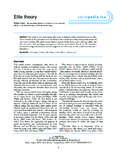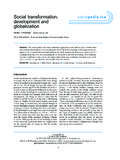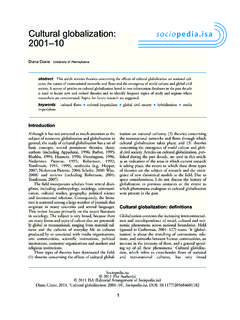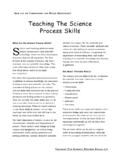Transcription of Sociolinguistics - SAGE Publications Ltd
1 2011 The Author(s) 2011 ISA (Editorial Arrangement of )Isabella Paoletti, 2011, Sociolinguistics , , DOI: first commandment of the study of discourse must be:Let people surprise you as to what they can do, and whatthey can use to do it. (Hymes, 1974: 102)We will be using observation as a basis for we can start with things that are not currentlyimaginable, by showing that they happened. We can thencome to see that a base for using close looking at the worldfor theorising about it is that from close looking at theworld we can find things that we could not, by imagina-tion, assert were there. (Sacks, 1984: 25)Introduction Sociolinguistics and language and Society are termsthat are often used interchangeably to refer to aninterdisciplinary field of research in which linguisticsand sociology, and other human sciences, join togeth-er to study verbal and other human conducts; but infact their definition is a highly controversial (Ammon et al.)
2 , 2006; Bratt-Paulstonand Tucker, 2003; Chambers, 2009; Coulmas, 2005;Coupland and Jaworski, 2009a, 2009b; Figueroa,1994; Halliday, 2007; Llamas et al., 2007; Mesthrie etal., 2009; Meyerhoff, 2006; Meyerhoff and Schleef,2010; Romaine, 2000; Trudgill, 2000) is a researcharea with a relatively short history (Gumperz andCook-Gumperz, 2008). Since the term was initiallycreated, it has adopted shifting shades of meaningsand until now it has not been univocally definable.(For a history of Sociolinguistics see: Bratt-Paulstonand Tucker, 1997; Figueroa, 1994; Hymes, 2000;Koerner, 1991; Rampton, 2006; Samarin, 2000).Hymes (1974: 195) writes: The term Socio -linguistics means many things to many people, andof course no one has a patent on its definition ; thisassertion would appear to be still valid are some of the research areas that have beenincluded under Sociolinguistics , in various combina-tions and according to different authors.
3 This group-ing of research areas is useful for descriptive reasons,but in fact many of these fields of research are strictlyinterrelated: Quantitative and qualitative approaches to thestudy of language and variationist Sociolinguistics ; Ethnographic and anthropological approaches tothe study of language; Language contact: Creole studies, code-switching,language death and survival, language rights and lan-guage policy; Discursive approaches to sociology and otherhuman term language and society offers the broadestmeaning, to include all the research areas, though it isfrequently used interchangeably with is certainly noticeable that there is a difference inSociolinguistics Isabella Paoletti Universidade Nova de Lisboa, Portugalabstract The aim of this entry is to provide a brief description of this interdisciplinaryarea of research, and to sketch its evolution.
4 The article stresses the importance of maintaining and devel-oping the legacy of interdisciplinary connections developed in the past and the social commitmentsbehind many of these studies. After describing the main areas in Sociolinguistics , some recent directionsare outlined, introducing some of its most promising approaches to human sciences uethnography of communication ulanguagecontact and language rights ulanguage and society usociolinguistics uvariationist Sociolinguistics 2 PaolettiSociolinguisticsthe meaning attributed to the term Sociolinguistics between Europe and the United States. In the 1960sthe term Sociolinguistics started to be used mainlyto refer to a broad area of studies in language andsociety on both sides of the Atlantic. It embracedvariationist Sociolinguistics , ethnography of commu-nication, anthropological linguistics, interactionalsociolinguistics, symbolic interactionism, conversa-tion analysis, discourse analysis and so on.
5 In orderto refer to this interdisciplinary coalition nowadays,Bucholtz and Hall (2008: 404), for example, use theterm sociocultural linguistics, mainly for reasons ofclarity. The term Sociolinguistics , they say, isincreasingly used, particularly in linguistics in theUSA, to define the study of how variations in lan-guage relate to sociocultural phenomena. Topics cov-ered include dialects, gender- and age-specific speechforms, professional jargon, etc. However, in Europe,Coupland and Jaworski (2009b: 2), for example,conclude that Sociolinguistics is now a broad andvibrant interdisciplinary project working across thedifferent disciplines that were its origins. In theiredited collection they include articles from all of thefields listed aim of this entry is to providea brief description of this interdisciplinary area ofresearch, and to give an idea of its evolution.
6 Thisarticle stresses the importance of maintaining theinterdisciplinary connections developed in the pastthat have shown themselves to be so very connections do not necessarily interfere withclarity in relation to disciplinary boundaries. AsBucholtz and Hall (2008: 403) point out: the devel-opment and spread of Sociolinguistics and linguisticanthropology, along with discourse analysis, conver-sation analysis, and many other approaches, has cre-ated an interdisciplinary foundation for the study oflanguage, culture, and society. These fields do notcome together under a single disciplinary banner butrather forge an alliance or coalition that fosters dia-logue and collaboration between complementaryapproaches. I also aim to point out the value of thesocial commitments behind many of the early stud-ies (Gumperz and Cook-Gumperz, 2008), hopingthat these can maintained and strengthened.
7 Afterintroducing the main areas in Sociolinguistics , Idescribe some of the most interesting and expandingfields. Then a discussion of possible future develop-ments of this interdisciplinary area of enquiry fol-lows. A few suggestions for further reading are main research areas insociolinguisticsSince the 1960s a very fruitful coalition has devel-oped among scholars in linguistics interested in therelation between social phenomena and language,while sociologists and social scientists becameincreasingly aware of the centrality of language inany social and cultural phenomenon (Ferguson,1959; Fishman, 1968; Giglioli, 1972; Gumperz andHymes, 1972; Hymes, 1964; Lambert, 1967; Laverand Hutcheson,1972; Pride and Holmes, 1972).Giglioli (1972: 7 8) writes: Some linguists havebecome concerned with socially conditioned linguis-tic phenomena, and some social scientists havebecome more aware of the social nature of term Sociolinguistics refers to this mutual con-vergence.
8 In the early days, Sociolinguistics was an interdis-ciplinary, loosely defined field of research in whichscholars, mainly in linguistics and sociology but alsoin anthropology, psychology, philosophy, education,gender study and so on, developed a wide variety oflines of research focusing on language and, mainly,on talk in interaction. Certainly, some perspectivesin sociology and in philosophy have contributedgreatly in creating an interest in language within thehuman sciences, in particular with regard to theimportance given to discourse and situated practices(Berger and Luckman, 1966; Bourdieu, 1977;Foucault, 1963; Giddens, 1976). For example, aninterest in and a focus on language was developedwithin sociology and it converged with the interestin sociology and other human sciences that hadindependently developed in linguistics.
9 In analysingtalk in interaction, conversation analysts study theproblem of order in ordinary conduct: the sociolog-ical problem par excellence. Sacks (1984: 21), defin-ing the field of conversation analysis, says: I want topropose that a domain of research exists that is notpart of any other established science. The domain isone that those who are pursuing it have come to callethnomethodology/conversation analysis. Thatdomain seeks to describe methods persons use indoing social life. The interest in language fell withinthe disciplinary boundaries; in other words, conver-sation analysts had no interest in language per se, butlanguage was of interest inasmuch as it could beinformative in relation to the machinery that holdsthe social world together. It is evident that conversa-tion analysis can be very interesting and useful to lin-guists; moreover, their investigations practicallyconverge with those in pragmatics, but this is a sortof extra bonus.
10 Nowadays, some of these lines of research, born3 PaolettiSociolinguisticsat the boundaries of various disciplines in the humansciences, constitute defined fields of enquiry that areclosely interrelated, such as linguistic anthropology(Duranti, 2009), ethnography of communication(Saville-Troike, 2002), pragmatics ( stman andVerschueren, 2009), conversation analysis(Schegloff, 2007), discourse analysis (Schiffrin et al.,2003), critical discourse analysis (Wodak and Meyer,2009), narrative analysis (Bamberg, 2007) and dis-cursive psychology (Potter, 2007); in fact, lookingback, the fertility of this interdisciplinary researcharea, based on discursive approaches to human sci-ences, is incredibly language studies, variationist linguistics had avery important role. In fact, in the USA, variationistsociolinguistics and quantitative approaches to lin-guistics (Labov, 1972, 2001) became prevalent in thefield of Sociolinguistics .














